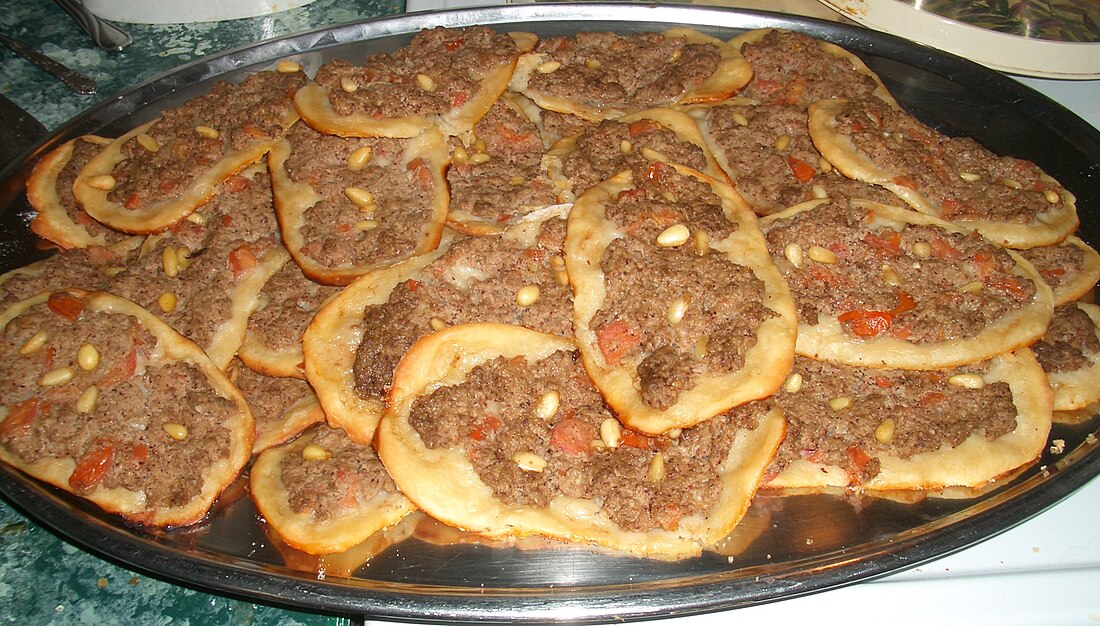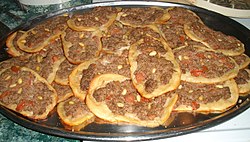Top Qs
Timeline
Chat
Perspective
Sfiha
Flatbread topped with mutton mince From Wikipedia, the free encyclopedia
Remove ads
Sfiha, esfiha, esfirra, sfija, sfihah, sfeeha or fatay (Arabic: صفيحة, romanized: ṣafīḥa) is a Lebanese dish consisting of flatbread cooked with a minced meat topping, often a mix of sheep and veal, and flavored with onions, tomatoes, pine nuts, and spices. It is traditionally found in the countries of the Levant,[1] and is closely related to manakish and lahmacun.[2] Sfiha is particularly associated with Baalbek, a city located in the Beqaa Valley of Lebanon.[3][4]
Sfiha has become popular in parts of South America, where it is known as esfiha or esfirra in Brazil or as empanada árabe ("Arab empanada"), fatay or sfija in Argentina, after being introduced by Arab Brazilians and Arab Argentines from the Levant and Armenia.[5][6]
Remove ads
History
Flatbreads have been present in the Fertile Crescent since prehistoric times. They have been cooked on hot surfaces such as stones, a metal sajj plate, taboon, or tandoor. In the medieval Arab world, with the development of the brick oven or furn, a wide variety of flatbreads baked together with stuffings or toppings emerged, including sfiha, and spread across the Ottoman Empire.[2]
In Brazil, esfiha gained popularity in the late 20th century, and since has become one of the most popular fast foods.[6]
Remove ads
Main ingredients
Every family has their own preference on what to add in addition to the meat. In Lebanon, the main ingredients are: meat, onions, tomatoes, pine nuts, salt, pepper, and flavorings such as cinnamon, sumac, or pomegranate molasses. The region of Baalbek is especially known for its sfiha.[7] In Syria,[8] Palestine,[9][10] and Jordan,[11] sfiha is similarly made with minced meat or lamb, in addition to herbs and spices, with tomatoes, onions, and other ingredients.[citation needed]
Esfihas in Brazil are oven-baked and may be open-faced flatbreads about four inches in diameter with meat topping,[12] or folded into a triangular pastry like fatayer. They may have various toppings, including cheese, curd, lamb, beef or vegetables.[citation needed]
Remove ads
Regional variations
Summarize
Perspective
Lebanon

Sfiha Baalbakiya (Levantine Arabic: صفيحة بعلبكية) is a variation of sfiha originating from Baalbek, Lebanon. It is a small meatpie with folded sides with a variety of toppings like nuts and lemon juice, often served for special occasions like weddings.[13][14][15] It's availability was impacted by the Lebanese liquidity crisis, which gave rise to cheaper, meatless versions.[14][16]
Palestine
Sfiha Yafawiyeh (Arabic: صفيحة يافوية, lit. 'Sfeeha from Jaffa') is a variant named after the city of Jaffa where, instead of topping flatbread with meat, the bread is rolled into a spiral shape with the meat used as a filling.[17][18]
In areas like Bethlehem, tahini is a core componant of sfiha.[19][20]
Latin America

Esfiha, or esfirra,[21] first appeared in Brazil following the arrival of Lebanese immigrants.[22][23]
Esfihas come in both sweet and savory forms, with toppings like sausage or chocolate.[22][24] Some esfihas are closed-faced rather than being open-faced like sfiha, making them more similar to fatayer.[21]
Brazilian fast food chains that offer Arab cuisine-inspired foods like Habib's sell hundreds of millions of esfihas a year.[23][25]
Similar dishes
Eish bi-lahm (Arabic: عيش باللحم, lit. 'bread with meat') is a Saudi Arabian dish very similar to sfiha. It is a large open-faced meat pie with minced meat and vegetables as filling, with the top covered in egg wash.[26][27]
Lahmacun
Lahmacun is referred to as sfiha in some regions, and the dishes are similar to one another. Lahmacun is also referred to as "Armenian sfeeha" (Arabic: صفيحة أرمنية, lit. 'Armenian sfeeha') in some places in the Arab world, such as Palestine where it is called that to distinguish it from the thicker Palestinian-style sfiha.[28][29][30]
Remove ads
See also
References
Wikiwand - on
Seamless Wikipedia browsing. On steroids.
Remove ads

